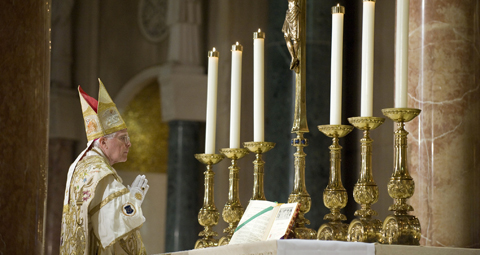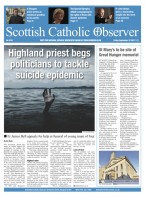September 15 | ![]() 0 COMMENTS
0 COMMENTS ![]() print
print

Mass is no place for axe-grinding
THE BOW IN THE HEAVENS appreciates the Latin Mass, but is less keen on the politics around it. - BY FR JOHN BOLLAN
I’m a big fan of the work of Sancta Familia Media, an initiative run by a couple of young chaps out of Holy Family parish in Mossend: they’ve quickly established a reputation for producing very professional videos (by my or anyone’s standards) relating to the life of the Church in Motherwell Diocese and throughout Scotland.
Most impressive, in my book at least, is their skill in operating a drone-mounted camera, offering breath-taking aerial shots of the life of the Church on the ground. If they ever grow tired of covering ecclesiastical affairs, I’m sure their services would be snapped up by a number of military intelligence agencies.
They recently covered two prominent events which occurred back-to-back over the same weekend. By far the biggest ‘do’ was the national pilgrimage at Carfin which, being in their home patch, was handsomely captured from all angles.
Scouring the footage as I have done, I’m at a loss as to why the St Joseph’s contingent weren’t sitting where they claimed to be. I sincerely hope they didn’t head off to the nearby M&D’s theme park (not for the first time) and merely swing past the Grotto on the way home to pick up some ‘alibi souvenirs.’
The other event covered by Sancta Familia, while not on such a grand scale, was also a big day: the visit to Glasgow by Cardinal Raymond Burke arranged by Una Voce Scotland. This Pontifical Mass, which attracted a large congregation, was also preserved for posterity in a very well put-together film. This also began with an impressive drone shot of the cardinal processing into the church, his scarlet cappa trailing behind him and held aloft by acolytes.
While I did not attend the Mass myself, I know some of those who did and they were full of praise for the work of the Immaculate Heart of Mary parish in Glasgow, the choir and indeed everyone involved.
The Church has been a hub for celebration of the Extraordinary Form of the Mass according to the Missal of St John XXIII promulgated in 1962. In my experience, there are few topics in the Church which prompt clergy to engage in such robust remonstration (a polite way of saying ‘lose it’) as the mention of the Tridentine Mass.
I have attended two Masses in the Extraordinary Form: one by accident, the other by design. The first, accidental, attendance was back in my student days in Rome. I had a friend, Loredana, who sang in a couple of choirs and who would invite me along from time to time to hear her sing.
One particular concert was being held in a church on the Via del Corso, the long straight street which connects the Piazza del Popolo to the Piazza Venezia (the ancient Romans called it the via Lata or Broadway). It was a performance of Mozart’s Requiem, a piece I had known and loved since writing about Peter Shaffer’s Amadeus for my Sixth Year English dissertation.
No sooner had I arrived in the church, which was very busy, than I began to wonder if this was quite the concert I was expecting. For a start, there were a lot of unusual costumes: I don’t mean black tie and evening dress, but lots of Ruritanian couture which I have since come to recognise as the uniform of long-suppressed Papal attendants. One even had a sword.
This was the first time I had seen a real sword, and certainly the first time I had seen one in church. Of course, there are more Samurai swords on display around this parish than in the Emperor of Japan’s armoury, but back then it was a startling novelty.
Being somewhat casually dressed for this grand occasion, I was grudgingly passed a booklet for this performance and a quick glance at the cover left me in no doubt that this would be a concert with a difference.
It was, in fact, a full Mass in the Old Rite organised by the ‘Association for the Glorification of (Pope) Pius IX.’ I have searched for this group on the internet and, having turned up a blank, I can only imagine that they have since disbanded. Possibly the Beatification of Pius IX in 2000 meant they had fulfilled their purpose.
Anyway, I was treated to a beautiful performance of Mozart’s Requiem and, thanks to the Mass itself, I was able to appreciate the various parts of the work as a piece of liturgical music, as it was originally intended. Beauty aside, I was quite abrupt with Loredana about the company I had been keeping that evening. “Don’t you ever do that to me again,” I warned her, albeit in my flawless Italian.
The other Extraordinary Mass I attended was here at St Joseph’s with my full knowledge and consent. I had been approached by a group of local parishioners who were keen to have such a Mass offered in this district. I was more than happy to comply with this request and to delegate its celebration to a visiting priest who was far more acquainted with the rubrics than me.
This Mass, on the feast of St Andrew in 2015, drew a large crowd of about 250. I’d say I recognised about half as parishioners and the other half were familiar to me as fellow Greenockians, along with another few visitors who had come from further afield.
The singing was led by a small schola and the folk seemed very impressed by what they had witnessed. For some, it was a return to the Mass of their childhood and youth; for others, it was an entirely new way of experiencing the Holy Sacrifice. As is often reported, there were more dark and full heads of hair in the pews than the silver which tends to predominate at the Masses round here.
After the Mass, I carried out some fairly rudimentary research among the people of St Joseph’s who had been present. Of those, a little over half said they absolutely loved it and would very much want to have more such Masses in the Extraordinary Form; the rest, while also loving or appreciating it, said they preferred Mass ‘as we have it now.’
To be honest, I have done nothing to attend to the request to have more such Masses at St Joseph’s. The main reason is that, were this to happen, I would not want to delegate it to ‘outsiders,’ no matter how welcome they always are. As someone with a PhD in Classics, I should, in theory, be able to navigate my way through a Latin Mass. But to get myself into a state of proficiency, it’s really necessary to observe the celebration of the Mass at first hand— and at close quarters—and I keep telling myself that I don’t have time to devote to that particular strand of my continuing professional development as a priest. Of course, if I really wanted to, I would find the time.
I’m conscious, therefore, of a dissonance in my own mind with regards to Mass in the Extraordinary form. It appeals to me aesthetically. Moreover, as a Roman historian, I can identify elements of religiosity which not only take us back to early expressions of the Church’s Eucharistic worship but also—and this might alarm some purists—there are also aspects of it which are continuous with pre-Christian Roman worship.
It is also, especially in its intricacy and the degree of attention which is required—even in the sacristy—a powerful antidote to the lack of focus which can afflict my own celebration of the sacred mysteries.
Even on a mundane level, how often have I scurried in before Mass with hardly a minute to spare and performed only the most perfunctory preparations? All that is put to bed by the vesting prayers of the Old Rite which effectively clothe you in an attitude of prayerfulness even as they wrap you in the layers of vesture you require for the Mass itself.
And yet… and yet I make excuses. Perhaps my principal concern is that this Mass should not be a vehicle of protest or nostalgia, but something free of such baggage. In other words, the Mass is no place for the grinding of axes—or the rattling of sabres (even Papal ones).











